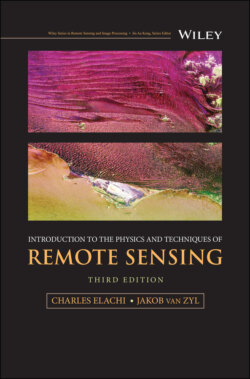Читать книгу Introduction to the Physics and Techniques of Remote Sensing - Jakob J. van Zyl - Страница 19
2.1.1 Electromagnetic Spectrum
ОглавлениеThe electromagnetic spectrum is divided into a number of spectral regions. For the purpose of this text, we use the classification illustrated in Figure 2.1.
The radio band covers the region of wavelengths longer than 10 cm (frequency less than 3 GHz). This region is used by active radio sensors such as imaging radars, altimeters, and sounders, and, to a lesser extent, passive radiometers.
The microwave band covers the neighboring region, down to a wavelength of 1 mm (300 GHz frequency). In this region, most of the interactions are governed by molecular rotation, particularly at the shorter wavelengths. This region is mostly used by microwave radiometers/spectrometers and radar systems.
The infrared band covers the spectral region from 1 mm to 0.7 μm. This region is sometimes subdivided into subregions called submillimeter, far infrared, thermal infrared, and near infrared. In this region, molecular rotation and vibration play an important role. Imagers, spectrometers, radiometers, polarimeters, and lasers are used in this region for remote sensing. The same is true in the neighboring region, the visible region (0.7–0.4 μm) where electronic energy levels start to play a key role.
In the next region, the ultraviolet (0.4 μm to 300 Å), electronic energy levels play the main role in wave–matter interaction. Ultraviolet sensors have been used mainly to study planetary atmospheres or to study surfaces with no atmospheres because of the opacity of gases at these short wavelengths.
X‐rays (300–0.3 Å) and gamma rays (shorter than 0.3 Å) have been used to an even lesser extent because of atmospheric opacity. Their use has been limited to low‐flying aircraft platforms or to the study of planetary surfaces with no atmosphere (e.g., Moon).
Figure 2.1 Electromagnetic spectrum.
